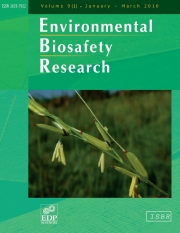Article contents
Modeling suggests frequency estimates are not informativefor predicting the long-term effect of horizontal gene transfer in bacteria
Published online by Cambridge University Press: 22 June 2006
Abstract
Horizontal gene transfer (HGT) is an important mechanism by which bacteria recombine and acquire novel genes and functions. Risk scenarios where novel plant transgenes transfer horizontally into bacteria have been addressed in numerical theoretical assessments and experimental studies. A key outcome of these studies has been that the frequencies of such inter-domain transfer are very low, if occurring at all, suggesting that such transfers would not occur at a level that is biologically significant. The relationship between transfer frequencies and the subsequent selection or genetic drift of transgene carrying bacteria often remains unresolved in these studies and assessments. Here we present a stochastic model to better understand the initial establishment and population dynamics of rare bacterial transformants carrying horizontally acquired (trans)genes. The following key parameters are considered: initial transformant numbers, strength of selection, bacterial population size and bacterial generations (time). We find that the initial number of transformants is important for the subsequent persistence of transformants only in the range of 1 to ~50 independent HGT events. Our simulations show that transformant populations under a wide range of HGT rates and selection coefficients undergo stochastic developments where they persist at low frequencies for up to several years (at frequencies that are below detection using available field sampling methodology), after which they eventually may go to fixation. Stochastic variability may thus play a crucial but disregarded role in the design of field monitoring strategies e.g. in biosafety assessments. We also estimate the time required for transformants to reach 0.0002% prevalence in a bacterial population, a threshold that allows experimental detection of transgene carrying bacteria through sampling of the larger bacterial populations.
Keywords
Information
- Type
- Research Article
- Information
- Copyright
- © ISBR, EDP Sciences, 2006
References
- 13
- Cited by

